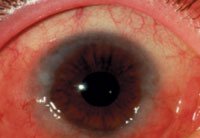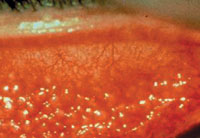For VKC, focus on relieving symptoms
The immunopathologic features of vernal keratoconjunctivitis (VKC) are more complex than a simple type 1 hypersensitivity reaction that occurs in the various other forms of allergic eye disease. For this reason, management of VKC is primarily concerned with relieving symptoms and preventing sight-compromising complications.
“The most effective treatment is to eliminate or avoid the offending antigen,” said Joseph P. Shovlin, OD, FAAO, a Primary Care Optometry News Editorial Board member who practices at Northeastern Eye Institute in Scranton, Pa. “Unfortunately, avoidance is not practical in most cases.”
Contemporary treatment guidelines
According to Dr. Shovlin, applications of cold compresses and chilled artificial tears have a palliative benefit. “Artificial tear use, at a minimum of four times a day, will help restore barrier function,” he said. “Topical vasoconstrictors and antihistamine agents help relieve itching and redness.”
Dr. Shovlin said mast-cell stabilizers can be useful before the condition flares or to provide maintenance therapy following acute therapy.
He also discussed his use of combination drugs, nonsteroidal anti-inflammatory drugs (NSAIDs) and topical steroids. “The combination antihistamine/mast-cell stabilizer agents, such as olopatadine and ketotifen, are quite effective for broad-spectrum activity,” he said. “NSAIDs (ketorolac, diclofenac) may offer some relief in moderately severe conditions.”
According to Elizabeth D. Muckley, OD, FAAO, director of contact lens services at Northeast Ohio Eye Surgeons in Kent, Ohio, optometrists can in some cases treat VKC pre-emptively.
“If you know the patient will develop VKC at the same time every year, I suggest starting with Patanol (olopatadine HCl, Alcon Labs, Ft. Worth, Texas) twice a day 2 to 4 weeks prior to prevent the symptoms of itching and mucous discharge as much as possible,” she said.
The use of steroids
In most cases, however, Dr. Muckley finds that a topical steroid is often needed to alleviate inflammation. “I generally use Alrex (loteprednol, Bausch & Lomb, Rochester, N.Y.) three to four times daily initially, combined with Patanol twice daily for 2 weeks,” she said. “Alrex is my steroid of choice due to the low incidence of steroid-induced increase in IOP. When the inflammation shows improvement, I will then slowly taper the Alrex. Lotemax (loteprednol etabonate, Bausch & Lomb) can also be used in extreme cases, but I generally achieve excellent results with Alrex.”
Dr. Muckley said she has found that Alrex works well in combination with Elestat (epinastine, Allergan, Irvine, Calif.), particularly for contact lens patients suffering from dry eye secondary to VKC. “The pH of Elestat is 7.0, which seems to not exacerbate the dryness and soothes the itching,” she said.
She added that Restasis (cyclosporine, Allergan) has also shown some promise in treating VKC, but she is generally hesitant to prescribe it at this time. “I am cautious in prescribing it, as it is not approved for use in patients younger than 16,” she said. “As with any off-label use of medication, I inform my patients and let them help in the decision-making. I would use Restasis in only extreme cases that do not respond to Alrex or in patients who have a known increase in IOP with steroid use.”
Dr. Shovlin said he reserves topical steroids for more severe, less controlled presentations of VKC. “Patients on topical steroids should be monitored for IOP increases,” he said.
 |  |
| Clinical presentation: VKC can appear as limbal gelatinus nodules (left) or superior cobblestone papillae (right). | |
Indolent shield ulcers
Shield ulcers are a dangerous, potentially sight-threatening presentation of VKC and should be treated in a quick and thorough manner. “A topical broad-spectrum antibiotic ointment (or drop) is required to avoid infection,” Dr. Shovlin said. “Topical steroids (loteprednol or fluorometholone) used four to six times a day are necessary and are used in tandem with aggressive cycloplegic agents.”
Dr. Muckley said, due to the excellent topical therapies currently available, she rarely sees shield ulcers. But if one develops, she uses Vigamox (moxifloxacin ophthalmic solution, Alcon Labs, Ft. Worth, Texas) every hour, depending on the severity of the epithelial defect. She said she will also add Ciloxan (ciprofloxacin, Alcon Labs, Ft. Worth, Texas) ointment four times daily to help cushion the mechanical interaction of the lid.
“A silicone hydrogel bandage contact lens can also be used to help buffer the interaction of the eyelid and to heal the underlying epithelium once you are sure the ulcer is responding to treatment,” she said. “I typically will then start aggressive steroid therapy as long as I am confident that the ulcer is re-epithelializing and improving after antibiotic coverage.”
Dr. Shovlin said patients with shield ulcers and plaque who do not re-epithelialize require surgical intervention. “Initial scraping of the ulcer at the base and margins, with removal of the inflammatory material, may provide for rapid re-epithelialization,” he said. “Supra-tarsal injection of immediate-acting steroid (triamcinolone) results in decreased recurrence and dramatic relief in symptoms.”
Recalcitrant and severe cases may require amniotic membrane transplantation in combination with debridement, Dr. Shovlin said.
For Your Information:
- Joseph P. Shovlin, OD, FAAO, can be reached at Northeastern Eye Institute, 200 Mifflin Ave., Scranton, PA 18503; (570) 342-3145; fax: (570) 344-1309; e-mail: JShovlin@aol.com.
- Elizabeth D. Muckley, OD, FAAO, can be reached at 2013 State Rt. 59, Kent, OH 44241; (330) 678-0201; fax: (330) 678-2482; e-mail: dredm1@aol.com. Neither Dr. Shovlin nor Dr. Muckley has a direct financial interest in the products mentioned in this article, nor is either a paid consultant for any companies mentioned.
